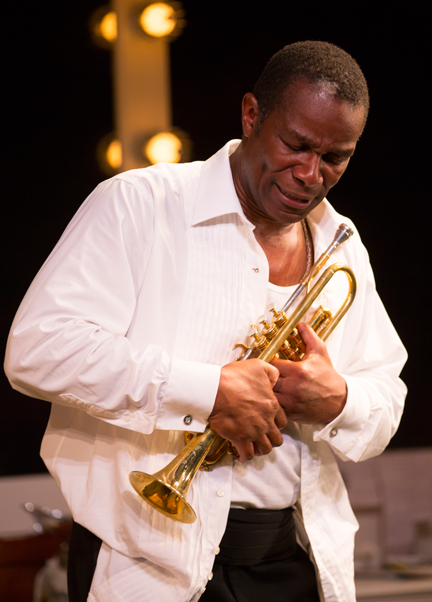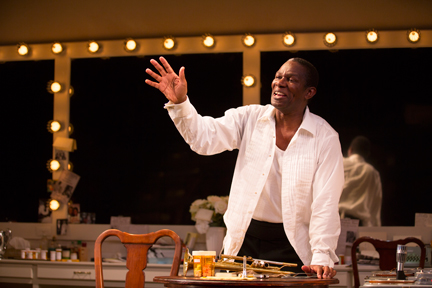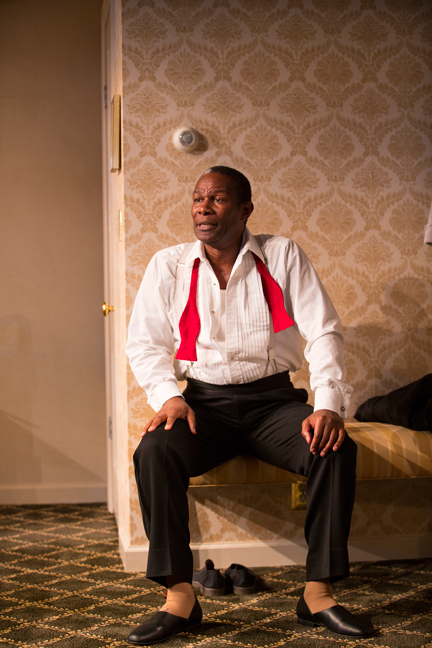The open door, upstage right, sends raking light into a backstage dressing-room, revealing an oxygen tank with mask, situated beside a small couch downstage left. He enters through the door, horn in hand, stooped, shaky, and hurries to the tank and inhales deeply. When he has caught his breath, he addresses the audience, telling us that he shit his pants earlier that day while in an elevator with his wife—here, at the Waldorf Astoria of all places! “He” is Louis Armstrong, a performing legend, an icon for jazz music and of successful blacks in show-biz, and he has just played a concert. Now, with a tape machine and microphone nearby, he sets out to describe his career, and to get on record his dealings with his lifelong manager, the deceased Joe Glaser. It’s a relationship that has all the classic traits of benevolence and betrayal, of closeness and crassness, of a shared passion for success and a regretful sense of not sharing enough.
He is John Douglas Thompson giving a bravura performance as both Armstrong and Glaser—with a couple notable asides in the voice and manner of a priggish Miles Davis—negotiating, with nimble shifts, the very different styles of speech and personal mannerisms of both characters. There’s no doubt, of course, that we will sympathize with Louis—his manner is so forthright, his humor so ingratiating, his sense of himself both humble and proud; what’s more remarkable is that we sympathize with Glaser too—which Louis might accept but which would also provoke him—because Glaser, a fast-talking Jew with a firm grasp of his place in the universe, is also a pawn of gangsters, of men who find the weak point in one’s armor and use it to their advantage. In other words, there is a major grievance that Louis lobs at Joe and it does stick, but there are extenuating circumstances.
Armstrong is no emotional weakling. He has gotten old, but he has also gotten rich, or way richer than he began, in any case, and he knows he’s had a great deal of luck on his side, and a great good fortune in choosing his manager wisely. He also knows that he owes a lot to Glaser, but that can’t distract him from what he owes Louis Armstrong, the famous name who, he believes, deserves better, deserves to be Glaser’s equal.
And that’s where this play, Satchmo at the Waldorf, by Terry Teachout, author of Pops, a biography of Louis Armstrong, now playing at the Long Wharf Stage II, really delivers the goods. Ultimately, this is a searching play, not simply about loyalties and the inevitable dissatisfaction at the end of the day, aired by two men who have been more than associates and less than bosom buddies, but also about a career that stepped over the “color barrier,” though not as a fully respected achievement. That’s where Davis’ jibes about Satchmo as an “Uncle Tom” come in, and are necessary to triangulate the story a bit. Armstrong relied on a Jew to smooth his way into the Big Time, and it worked, but, by Louis’s own admission, he allowed himself to become Glaser’s “nigger.” It’s to Teachout’s credit that he is able—without becoming didactic—to give the audience some sense of the dimensions of that term. Not simply a word of disdain, it becomes, in Satchmo’s mouth, a recognition of himself as a certain kind of creation: a black person who will be acceptable to, indeed loved by, devoted white audiences—a great aside on this theme occurs when Louis gestures to the mostly white audience at the Long Wharf to underscore his view that “white folks” never tire of him, while his “own people” lost interest in him long ago.
The difficulty of a black performer “crossing-over” to a white audience on his own terms—in the times Louis Armstrong lived through—gives the play much of its punch, and it also shows up the callousness of Miles Davis’s privileged sneer. Davis was too cool to kowtow to white tastes, but then, he didn’t have to. Times had changed, and, indeed, Armstrong’s comments show him to be not only knowledgeable about race in America but also about class amongst blacks.
In Teachout’s Armstrong we see a cursing, earthy, funny, human, likeable, approachable star—a man who made his way by making people feel good. If some of what makes white folks feel good is being excited about a black man, well, Louis was willing to be that black man—as he says, almost every white person has one black person “they crazy about.” The play sees Armstrong for what he is—a crowd-pleaser in a time when the crowd that mattered was mostly white—but also shows what he sees: that his own race’s condescension toward him implies a denial of their own history, and of the importance of figures like himself in being ambassadors of race in the special world of show-biz: a person with enough clout to give President Eisenhower a dressing-down over Little Rock that stuck.
Satchmo at the Waldorf is also quite adept at making us feel the presence of the many special interests outside the cozy dressing-room where Louis decompresses between performing and going to his supportive and cherished wife, Lucille. Those interests include mob bosses, and it’s no negative reflection upon Armstrong that he rose to prominence upon such associations—rather, it’s to Teachout’s credit that he keeps that aspect of early twentieth-century show-biz in play. Hearing Glaser’s voice adds immeasurably to our grasp of not only the dynamic between these two men, but of the world Glaser inhabited and, mostly, conquered. We’re looking at two of the winners, and the fact that there are real compromises, real costs, and real conviction behind their mutual affection for and dissatisfaction with each other shows us, by implication, the harsh realities that underlie “making it.”
John Douglas Thompson seems ideal for the part: more athletic-looking than Armstrong in real life, he is yet able to inhabit the man, giving us a compelling sense of a great performer who is confiding in us, and who is dropping his guard, at times, for the sake of clarifying his own raw emotions. It is a performance full of energy and reflection, pleasure and pathos—it gives depth to a man who, on stage, was willing to seem as untroubled as a ray of sunshine. And to see Thompson become a calculating, calculated Jew is a transformation that goes beyond comic relief—by having Glaser play “straight man” to Armstrong’s monologue, Thompson and director Gordon Edelstein avoid caricature and let Glaser be the voice of reality, of the smarts necessary to make the deals that make the duo prosper.
If you’re thinking this one man show might have the bare stage and stream-of-conscious styling of some one-person shows, guess again. This is a play you can settle into as Louis settles into his reminiscences on a stage set that feels so authentic, you fully believe he will be spending the night in another room in the famed hotel, and that we are simply privy to the largesse of a personal reception between the public performance onstage and the private life he exits to join. Satchmo at the Waldorf may well set a new standard for the character-driven celebrity monologue. One begins to imagine many other backstage passes to an audience with a garrulous great we might hope to be given by future playwrights. It certainly helps to know your star well before he starts talking. Teachout certainly does and he compresses much of what he knows into drama that is forthright and effective, never bogged down with exposition or too elliptical to be entertaining. Teachout, Thompson, Edelstein and Long Wharf give us a star setting us straight, an uncensored charmer who’s got what it takes to tell it like it is.
John Douglas Thompson in Satchmo at the Waldorf By Terry Teachout Directed by Gordon Edelstein
Set Design: Lee Savage; Costume Design: Ilona Somogyi; Lighting Design: Stephen Strawbridge; Sound Design: John Gromada; Production Stage Manager: Hope Rose Kelly
Oct 3-Nov 4, 2012
Long Wharf Theatre, Stage II
Photos by T. Charles Erickson


